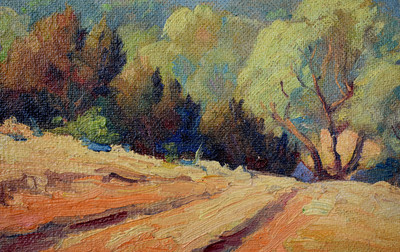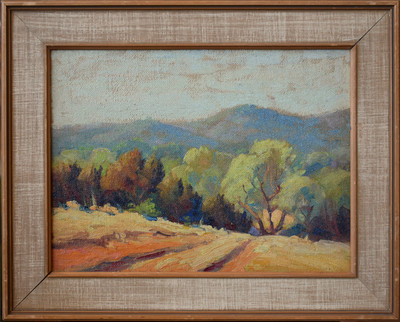Frank Earl Klepper was born on May 3, 1890, in Plano, Texas, growing up in McKinney, Texas. An artist of many parts, Klepper was a well-known, influential teacher as well as a painter of portraits, still-lifes, landscapes and animals. He was also a ceramist, graphic artist and muralist. Though he remained best known as a landscape painter, Klepper, over his career, moved from an impressionistic landscape style to a concentration on the so-called "Deep South" pictures, to experiments with symbolic painting. Klepper's work has been described by American artist Richard Miller"His wide range of subjects is remarkable, and his frankness and novelty of observation creates interest in all of his work. The poetry of light, direct or reflected, is one of the finest things of his art."
As a teenager, Klepper had to leave school to work in a grocery store to help support his family. On his own initiative, he studied anatomy in a physician's office above the store. He later attended the Aunspaugh Art School, Dallas, and, briefly in 1908, Dallas University. He supported himself in his studies at the Art Institute of Chicago, in 1914, by working in the Institute cafeteria and as an usher in a theater at night.
When World War I began, Klepper tried to join the army, he was rejected because of high blood pressure and heart leakage. But, determined to get into the army, he passed a second physical examination by drinking many glasses of ice water and lying on his back before the examination. He served on the Mexican border with the Fourth Texas Infantry Regiment, then in France in 1919 with the Thirty-sixth (Texas) Division. After the Armistice, Klepper took advantage of his French locale to study with the American painter Harry B. Lachman at the American Art Training Center at Bellevue-La-Montagne, and with several French artists.
Klepper moved back to McKinney when he returned to the United States in 1920. A sale of his paintings for $500. changed his post-war plans to become a businessman rather than an artist. And, his winning, also in 1920, of the Arthur A. Everts medal for landscape painting at the Texas Artists Exhibition helped establish his reputation. In 1927, Klepper moved to Dallas where he founded the Southwestern School of Fine Arts with David Guian, a musician, also serving as chairman of the art department at the Dallas Woman's Forum. A year later, in 1928, he studied in France and Belgium and worked with George Elmer Browne, a New York artist there. He would also visit Taos, New Mexico.
His long career as a teacher of etching and ceramics in the Dallas Public Evening School began in 1929, and he resumed his association with the Dallas Woman's Forum art department. His establishment of the Klepper Sketch Club, in 1930, was a landmark event. It became an important, long-term, local institution with the participation of many well-known Dallas artists. From 1932-1935, Klepper was director of the art department at Kidd-Key College, Sherman, until the college closed. His increased skill in lithography and etching won him the Southern States Art League first prize for bookplate design in 1932. And, he was selected to exhibit his work at the Texas Centennial Exposition in 1936.
In 1937, Kleeper went to Peking, China, but pre-World War II turmoil forced him to Tokyo, where he stayed for five months. His study of Oriental art is thought to have influenced his later work. He taught in the occupational therapy unit at Ashburn General Hospital, McKinney, during World War II.
Klepper died of a heart attack in Dallas on June 4, 1952, and was buried in McKinney. Since he never married, he gave the McKinney Memorial Public Library a valuable collection of books, sculpture, Oriental porcelain and other Chinese treasures.
Frank Klepper was a member of the American Artists Professional League; American Federation of Arts; Arkansas Art Association (honorary, life); Art Club, McKinney (honorary); Dallas Art Association; Dallas Woman's Forum (honorary); Klepper Sketch Club, and Highland Park Society of Arts, Dallas; New Orleans Art Association; Southern States Art League; and Texas Fine Arts Association.
He was commissioned to paint murals by the Federal Arts Project of the WPA in the McKinney post office and Prairie View College (now Prairie View A&M University) in Hempstead, Texas. Other Klepper murals may be found at Collin County Historical Society, McKinney (painted in 1934, it is a Civil War triptych depicting a Confederate Company leaving McKinney); McKinney Memorial Public Library; and public schools in McKinney and Plano.
By 1950, a number of Klepper's works were in permanent collections: a wildflower study, Texas Plumes, in Paris, Texas; Texas Shrine (the Alamo) at the Dallas Museum of Art; and Liendo, a painting of the sculptor Elisabet Ney's home near Hempstead, at the Elisabet Ney Museum in Austin. Other collections holding the artist's works include the Texas Fine Arts Association, Austin; Dallas Woman's Forum; Art Club, McKinney; Waco Art League; Arkansas State Collection, and Fine Arts Club of Arkansas, Little Rock; and the John H. Vanderpoel Art Association, Chicago.
Frank Klepper entered numerous exhibitions including Annual Texas Artists Exhibition, Fort Worth; Galveston Cotton Carnival Annual Exhibition; Annual Exhibition of Texas Artists, Dallas Woman's Forum and Southern States Art League Annual Exhibition.
Source:
John and Deborah Powers, "Texas Painters, Sculptors, and Graphic Artists"
http://www.tsha.utexas.edu/handbook/online/articles/view/KK/fkl10.html



